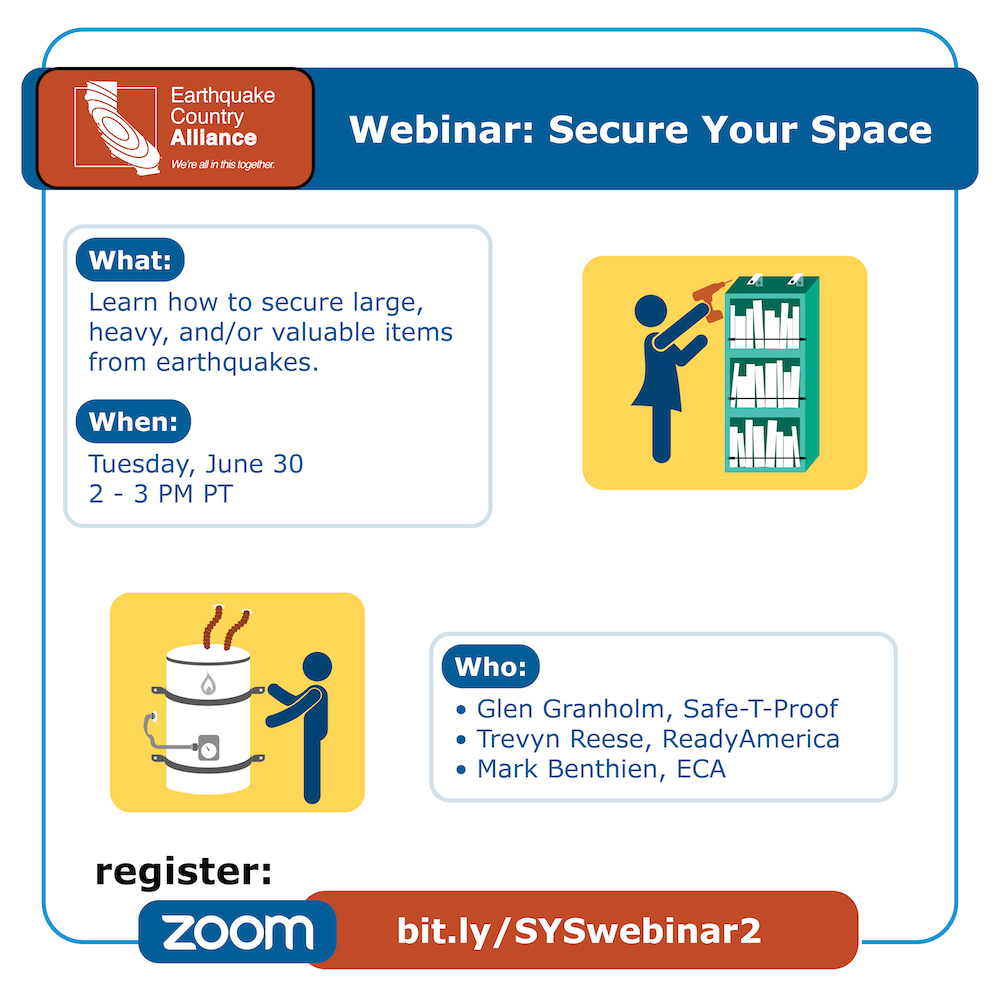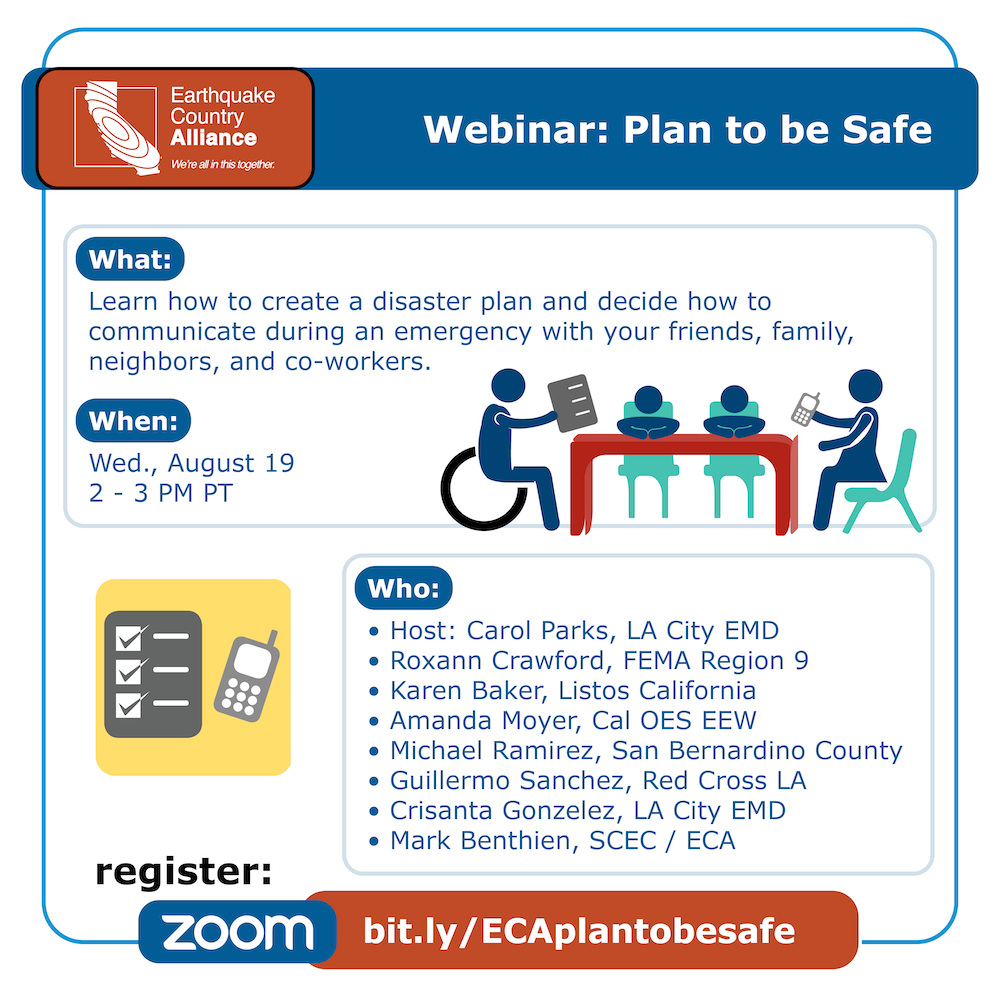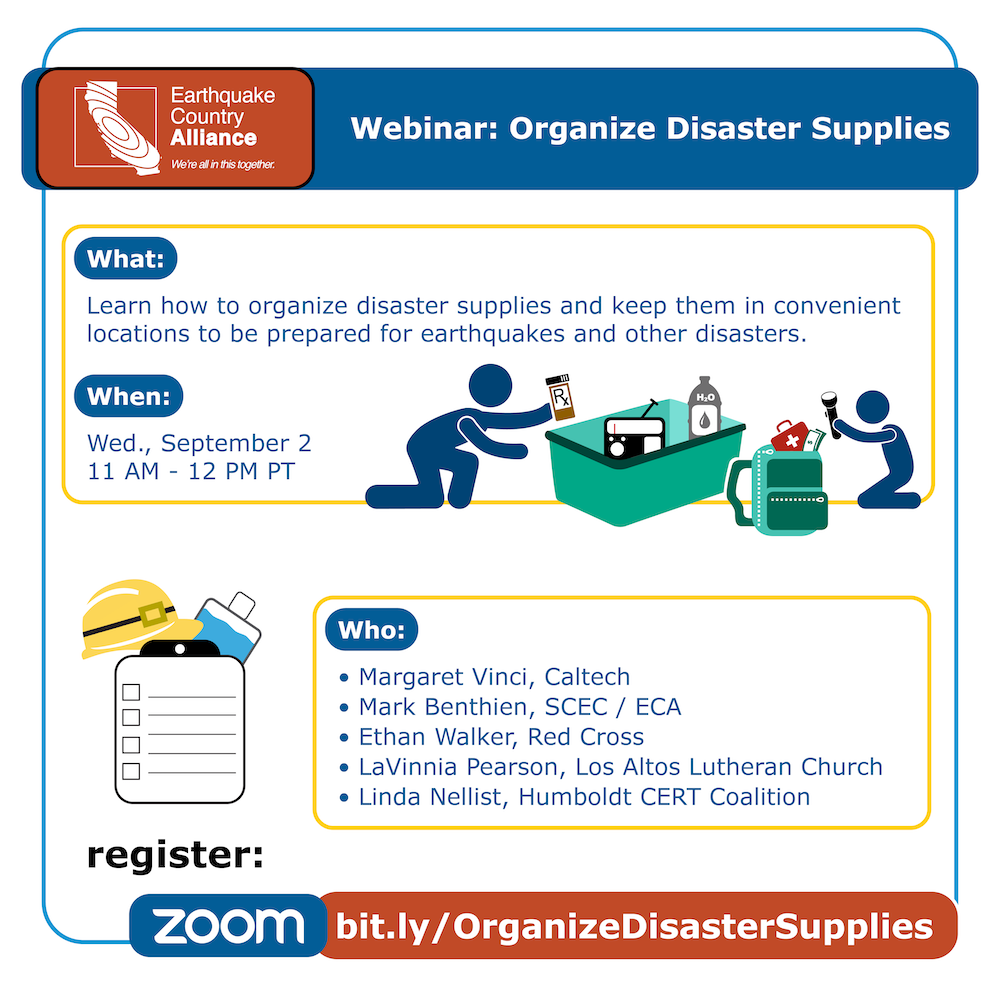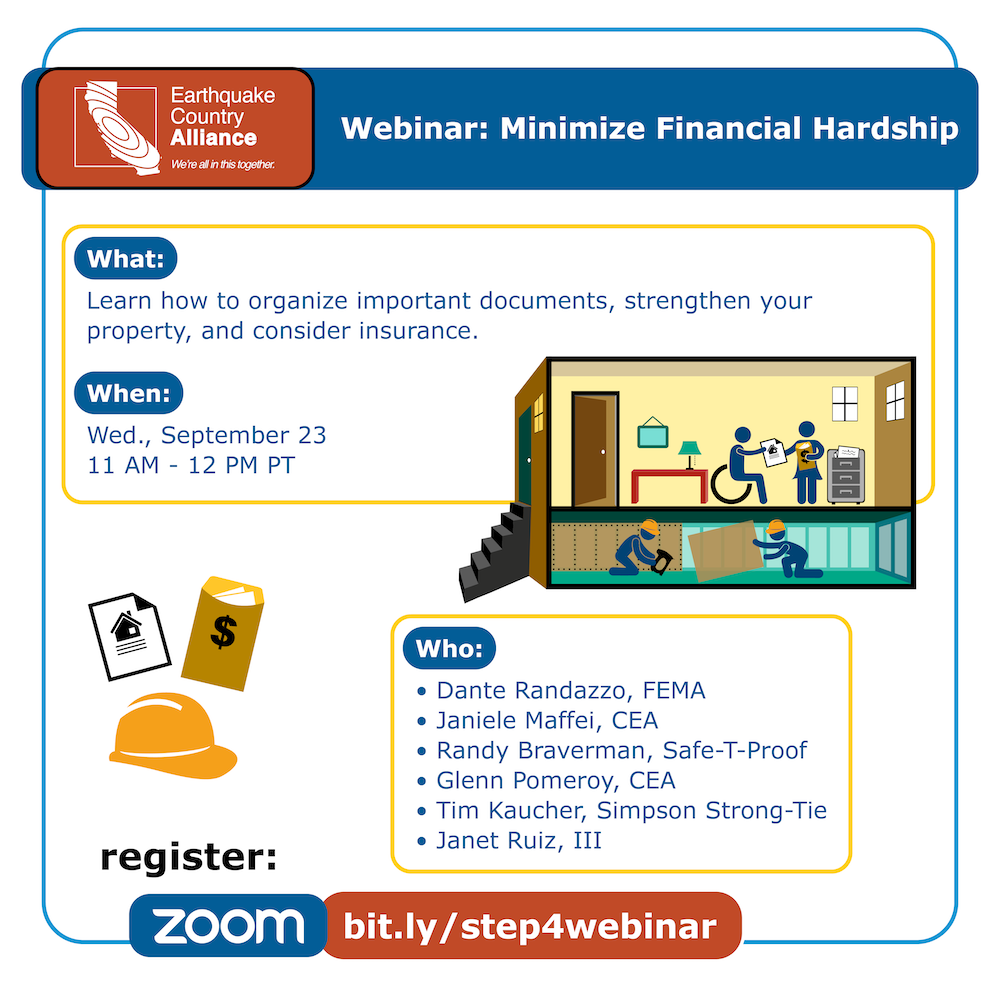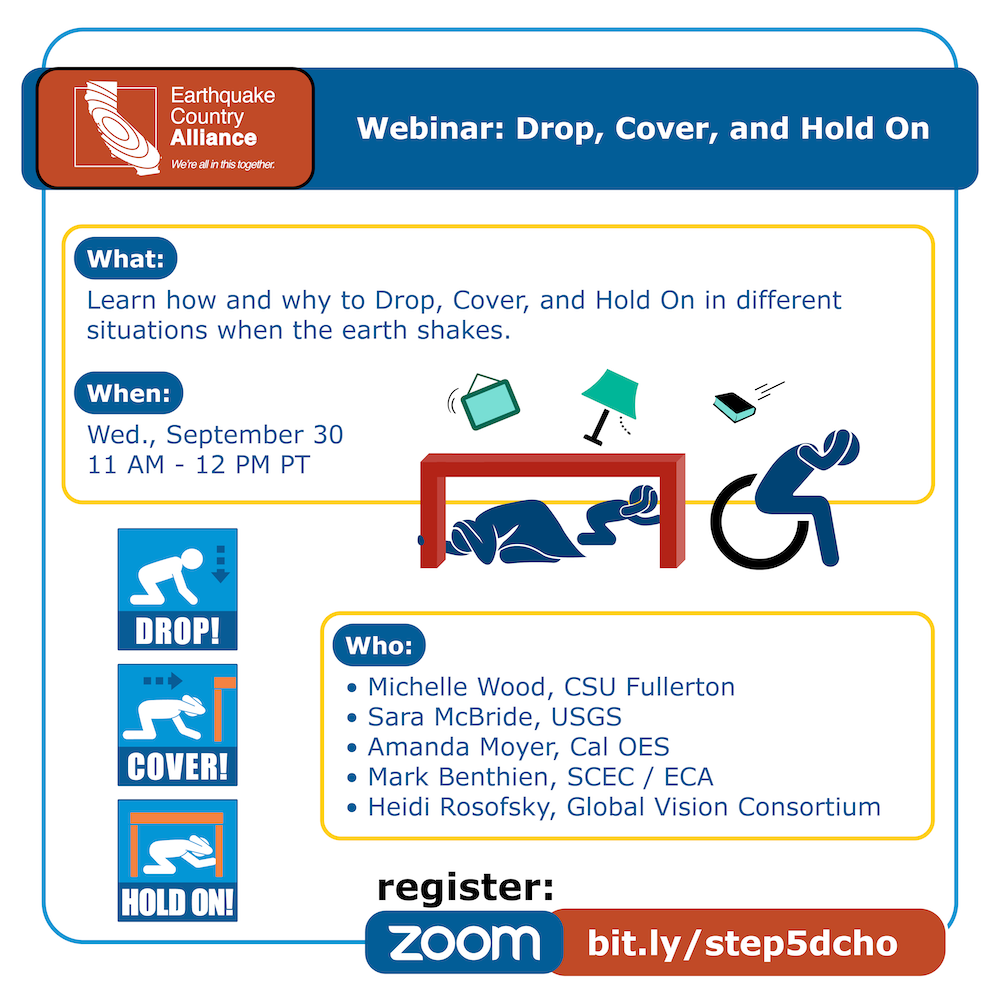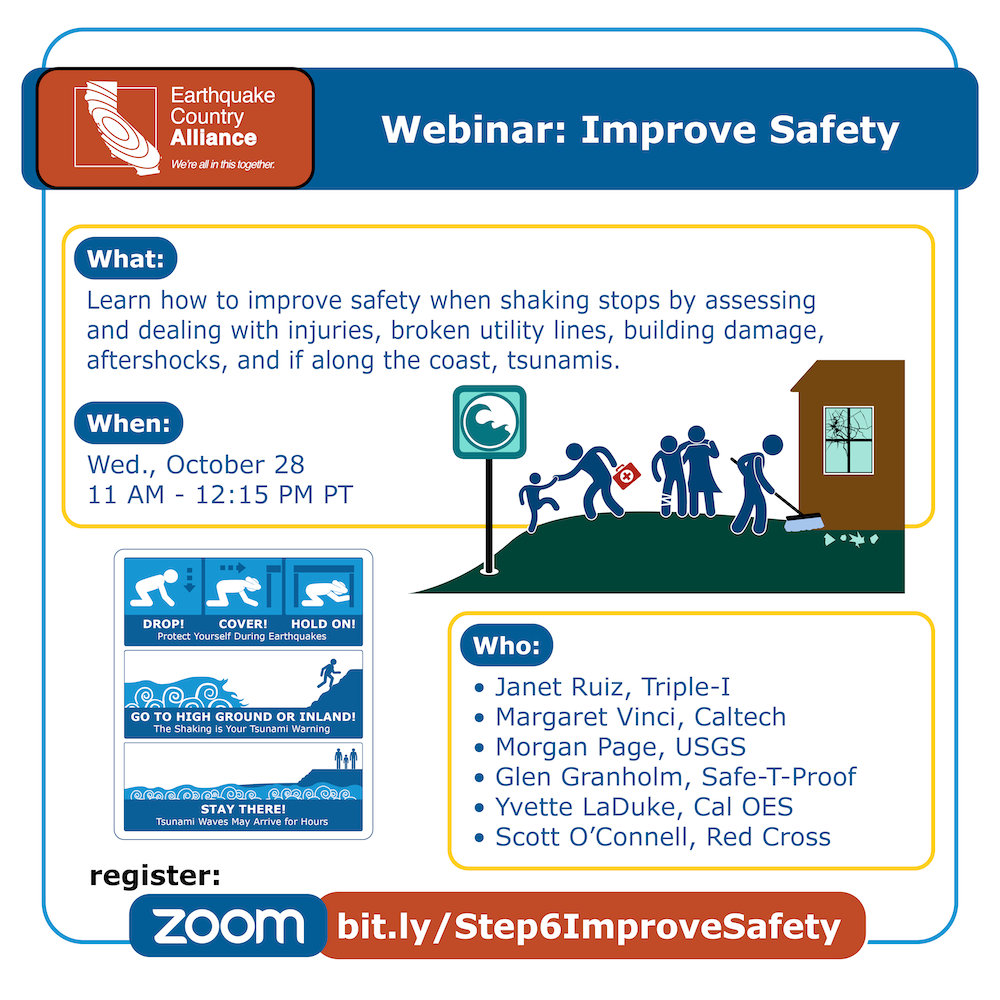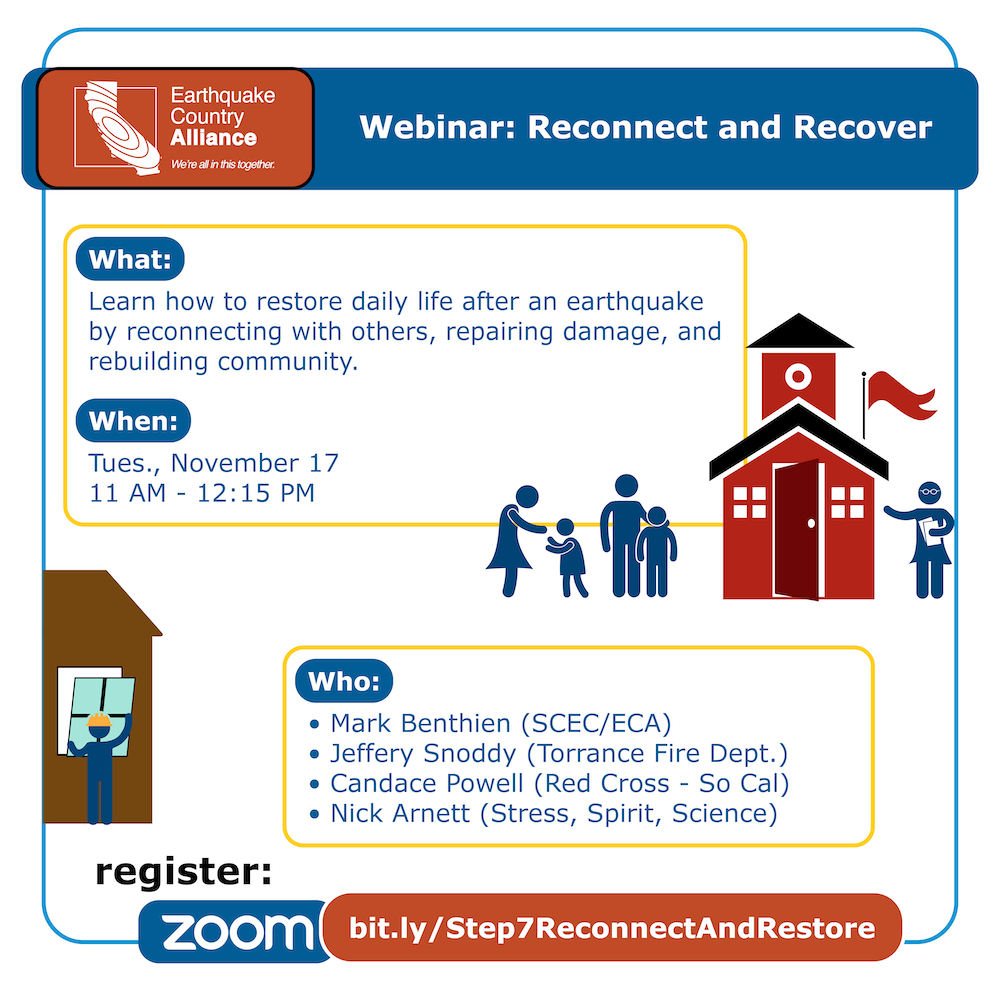Those of us who live in earthquake country know that large earthquakes may happen at any time. Fortunately there are simple steps we all can take to be “safer at home” before the earth shakes– even while being safer at home due to COVID-19 (or as we adapt to new, modified workplace and public environments).
This is why the Earthquake Country Alliance is the Safer At Home Webinar Series, with a special webinar for each of the Seven Steps to Earthquake Safety. The information provided will also be useful in the workplace or in schools.
Step 1: Secure Your Space (June 30, 11am): Recording and presentation
Step 2: Plan to Be Safe (August 19, 2 pm): Recording, presentation, and key links
Step 3: Organize Emergency Supplies (September 2, 11 am): Recording and presentation
Step 4: Minimize Financial Hardship (September 23, 11 am): Recording and presentation
Step 5: Drop, Cover, and Hold On (September 30, 11 am): Recording and Presentation
Step 6: Improve Safety (October 28, 11 am): Recording and Presentation
Step 7: Reconnect and Restore (November 17, 11am): Recording and Presentation
STEP 1: Secure Your Space
Tuesday, June 30, 2020
This webinar (recording below) focuses on Step 1 of the Seven Steps to Earthquake Safety: Secure Your Space by identifying hazards and securing moveable items.
Earthquake shaking can move almost anything, even large or heavy items. Imagine your home or workplace being picked up and shaken sideways – what would be thrown around? What might hit you or others, what valuables might be damaged, and how might your exits be blocked?
The webinar shows how easy it is to secure contents in your home (or elsewhere) to reduce these dangers to life and property. Live demonstrations and videos from industry experts show how to install or apply straps, latches, and other fasteners, while answering questions.
Closed captions are available in English and Spanish in the recording below.
Host
Ines Pearce (Chief Executive, Pearce Global Partners
& Chair, ECA Business Committee)
Presenters
Mark Benthien (Associate Director, So. California Earthquake Center (SCEC) @ USC & Executive Director, Earthquake Country Alliance)
Glen Granholm (Vice President, Safe-T-Proof)
Trevyn Reese (Account Manager, Ready America)
Moderators
Sharon Sandow de Groot (Director for Strategic Partnerships,
SCEC @ USC & Deputy Director, ECA)
Jason Ballmann (Communications Manager, SCEC @ USC & Media/Participation Bureaus Liaison, ECA)
Webinar Resources and Links
Step 1 Presentation Slides (PDF)
Step 1 Video Recording (Youtube; also view below)
If you attended (or after watching the following recording), please complete our brief survey.
|
(Click “CC” to see captions, once the video starts playing) |
STEP 2: Plan to Be Safe
Wednesday, August 19, 2020, 2-3pm
This webinar (recording below) focuses on Step 2 of the Seven Steps to Earthquake Safety: Plan to Be Safe by creating a disaster plan and deciding how you will communicate in an emergency.
If you attended (or watched the recording, below), please complete our brief survey.
The experts listed below highlighted and demonstrated simple actions and plans that will improve safety and speed recovery for you and your community. By planning now, you will be ready!
Closed captions are available in English and Spanish in the recording below.
Host:
Carol Parks (Assistant General Manager, City of Los Angeles Emergency Management Department) & Chair, ECA Public Sector Committee)
Presenters
Amanda Moyer (Executive Officer, California Earthquake Early Warning Program, CalOES)
Mark Benthien (Associate Director, So. California Earthquake Center (SCEC) @ USC & Executive Director, Earthquake Country Alliance)
Michael Ramirez (Supervising Emergency Services Officer, County of San Bernardino Office of Emergency Services)
Guillermo Sanchez (Preparedness Manager, American Red Cross Los Angeles)
Crisanta Gonzalez (Emergency Management Coordinator, City of Los Angeles)
Roxann Crawford (Disability Integration Specialist, FEMA Region IX)
Karen Baker (Co-Chair, Listos California, Cal OES)
Moderators
Sharon Sandow de Groot (Director for Strategic Partnerships, SCEC @ USC & Deputy Director, ECA)
Jason Ballmann (Communications Manager, SCEC @ USC & Media/Participation Bureaus Liaison, ECA)
Webinar Resources and Links
Step 2 Presentation Slides (PDF)
Step 2 Video Recording (Youtube; also view below)
California Earthquake Early Warning
Earthquake safety information for people with disabilities and other access and functional needs (English and Spanish)
Earthquake safety guidance for a variety of situations, in English and Spanish
ShakeOut registration and guidance in English and Spanish
VIDEO: How to Use a Portable Fire Extinguisher
American Red Cross trainings, App, and other resources
City of L.A. Emergency Management Department: Alerts, Ready Your LA Neighborhood, and much more
You Are the Help Until Help Arrives (FEMA/Ready)
Listos California: Emergency Preparedness Campaign Toolkit
(Guides, Digital Graphics, and Curriculum Materials)
If you attended (or after watching the following recording), please complete our brief survey.
|
(Click “CC” to see captions, once the video starts playing) |
STEP 3: Organize Emergency Supplies
Wednesday, September 2, 2020, 11am-12pm
This webinar (recording below) focuses on Step 3 of the Seven Steps to Earthquake Safety: Organize Emergency Supplies in Convenient Locations.
The experts listed below each discussed how to organize supplies for different purposes and locations, and showed examples “live” during the webinar.
Live captioning (CART service) was available during the webinar; closed captions are available in English and Spanish in the recording below.
Host
Mark Benthien (Associate Director, So. California Earthquake Center (SCEC) @ USC & Executive Director, Earthquake Country Alliance)
Presenters
Margaret Vinci (Manager, Caltech Office of Earthquake Programs & Chair, Earthquake Country Alliance Southern California)
Ethan Walker (Regional Preparedness Manager, American Red Cross Central California Region)
LaVinnia Pierson (Associate of Pastoral Care and Outreach, Los Altos Lutheran Church)
Linda Nellist (Lead Instructor, Humboldt CERT Coalition & member, Redwood Coast Tsunami Work Group)
Moderators
Sharon Sandow de Groot (Director for Strategic Partnerships,
SCEC @ USC & Deputy Director, ECA)
Jason Ballmann (Communications Manager, SCEC @ USC & Media/Participation Bureaus Liaison, ECA)
Webinar Resources and Links
Step 3 Presentation Slides (PDF)
Step 3 Video Recording (Youtube; also view below)
If you attended (or after watching the following recording), please please complete our brief survey.
|
(Click “CC” to see captions, once the video starts playing) |
STEP 4: Minimize Financial Hardship
Wednesday, September 23, 2020, 11am-12pm
This webinar (recording below) focuses on Step 4 of the Seven Steps to Earthquake Safety: Minimize Financial Hardship by organizing important documents, strengthening your property, and considering insurance.
The experts listed below discussed each of these elements, along with “live” demonstrations during the webinar.
Live captioning (CART service) was available during the webinar; closed captions are available in the recording below.
Host and Presenter
Janet Ruiz (Director – Strategic Communications, Insurance Information Institute & Media Bureau Coordinator, Earthquake Country Alliance Bay Area)
Presenters
Dante Randazzo (Federal Preparedness Coordinator, FEMA Region 9)
Janiele Maffei (Chief Mitigation Officer, California Earthquake Authority)
Glenn Pomeroy (Chief Executive Officer, California Earthquake Authority)
Randy Braverman (Project Manager Earthquake Brace + Bolt Program,
Safe-T-Proof Disaster Preparedness Co.)
Tim Kaucher (Engineering Manager Southwestern U.S., Simpson Strong-Tie)
Moderators
Mark Benthien (Associate Director, So. California Earthquake Center (SCEC) @ USC & Executive Director, Earthquake Country Alliance)
Sharon Sandow de Groot (Director for Strategic Partnerships,
SCEC @ USC & Deputy Director, ECA)
Jason Ballmann (Communications Manager, SCEC @ USC & Media/Participation Bureaus Liaison, ECA)
Webinar Resources and Links
Step 4 Presentation Slides (PDF)
Step 4 Video Recording (Youtube; also view below)
After viewing the Step 4 webinar, please complete our brief survey.
|
(Click “CC” to see captions, once the video starts playing) |
STEP 5: Drop, Cover, and Hold On (and other Self-Protection Guidance)
Wednesday, September 30, 2020, 11am-12:15pm
This webinar (recording below) focuses on Step 5 of the Seven Steps to Earthquake Safety: Drop, Cover, and Hold On when the earth shakes or you get an alert.
The experts listed below shared:
- Research about how people get injured during earthquakes as the basis for why certain self-protective actions are recommended;
- When to know you should take action; and
- What to do in various locations and with various capabilities, including if you have a disability.
Live captioning (CART service) and Sign Language Interpretation was available during the live webinar, sponsored by the City of Los Angeles Department of Disability. Closed captions are available in the recording below.
Register to Attend
Host
Shannon Mulhall (Americans with Disabilities Act Coordinator, City of Fresno & Chair, Seniors & People with Disabilities Committee, Earthquake Country Alliance)
Presenters
Michele Wood (Professor and Chair, CSU Fullerton Department of Public Health)
Sara McBride (ShakeAlert Social Science Coordinator, United States Geological Survey)
Amanda Moyer (Executive Officer, California Earthquake Early Warning Program, CalOES)
Mark Benthien (Associate Director, So. California Earthquake Center (SCEC) @ USC & Executive Director, Earthquake Country Alliance)
Heidi Rosofsky (Inclusive Planning Specialist, Global Vision Consortium & Chair, Earthquake Country Alliance Southern California)
Moderators
Sharon Sandow de Groot (Director for Strategic Partnerships, SCEC @ USC & Deputy Director, ECA)
Jason Ballmann (Communications Manager, SCEC @ USC & Media/Participation Bureaus Liaison, ECA)
Webinar Resources and Links
Step 5 Presentation Slides (PDF)
Step 5 Presentation References (PDF)
Step 5 Video Recording (Youtube; also view below)
After viewing the Step 5 webinar, please complete our brief survey.
|
(Click “CC” to see captions, once the video starts playing) |
STEP 6: Improve Safety
Wednesday, October 28, 2020, 11am-12:15pm
This webinar (recording below) focuses on Step 6 of the Seven Steps to Earthquake Safety: Improve Safety.
The experts listed below discussed what to do immediately after earthquakes, including:
- Maintaining personal safety
- Being alert for aftershocks (and what to expect)
- Evacuating to high ground or inland, if shaking is felt near the coastline or an official tsunami warning is issued)
- Communicating and staying informed
- Helping the injured
- Preventing further injuries or damage
Live captioning (CART service) was available during the webinar; closed captions are available in the recording below.
Host
Janet Ruiz (Director – Strategic Communications, Insurance Information Institute & Media Bureau Coordinator, Earthquake Country Alliance Bay Area)
Presenters (in order of speaking)
Margaret Vinci (Manager, Caltech Office of Earthquake Programs & Chair, Earthquake Country Alliance Southern California)
Morgan Page (Research Geophysicist, USGS)
Glen Granholm (Vice President, Safe-T-Proof)
Scott O’Connell (Regional Disaster Officer, American Red Cross Central California Region)
Yvette LaDuke (Tsunami Planning Coordinator, California Governor’s Office of Emergency Services)
Moderators
Mark Benthien (Associate Director, So. California Earthquake Center (SCEC) @ USC & Executive Director, Earthquake Country Alliance)
Sharon Sandow de Groot (Director for Strategic Partnerships, SCEC @ USC & Deputy Director, ECA)
Jason Ballmann (Communications Manager, SCEC @ USC & Media/Participation Bureaus Liaison, ECA)
Webinar Resources and Links
Step 6 Presentation Slides (PDF)
Video Recording of the Step 6 Webinar (Youtube; also view below)
After viewing the Step 6 webinar, please complete our brief survey.
|
(Click “CC” to see captions, once the video starts playing) |
STEP 7: Reconnect and Restore
Tuesday, November 17, 2020, 11am-12:15pm
This webinar (recording below) focuses on Step 7 of the Seven Steps to Earthquake Safety: Reconnect and Restore.
The experts listed below will discuss what to do in the days and weeks following earthquakes, including:
- Maintaining safety and preventing further damage (during aftershocks, etc.)
- Reconnecting with family, friends, and others
- Preparing insurance claims
- Helping neighbors
- Being cautious with food and water (which may have spoiled or become contaminated)
- Understanding when to evacuate, and what to bring if you need to stay in a shelter
- Applying for Government disaster assistance
- Balancing stress and other well-being matters
Live captioning was available during the webinar and closed captioning is available in the recording through YouTube, below.
Host
Mark Benthien (Associate Director, So. California Earthquake Center (SCEC) @ USC & Executive Director, Earthquake Country Alliance)
Presenters (in order of speaking)
Jeffrey Snoddy (Emergency Services Manager, City of Torrance Fire Department & Communications Coordinator, Earthquake Country Alliance Southern California)
Candace Powell (Disaster Program Manager, American Red Cross Southern California Region)
Nick Arnett (Critical Incident Stress Management and resilience leader, instructor, and author, Stress, Spirit, Science)
Moderators
Sharon Sandow de Groot (Director for Strategic Partnerships, SCEC @ USC & Deputy Director, ECA)
Jason Ballmann (Communications Manager, SCEC @ USC & Media/Participation Bureaus Liaison, ECA)
Webinar Resources and Links
Step 7 Presentation Slides (PDF)
Video Recording of the Step 7 Webinar (Youtube; also view below)
After viewing the Step 7 webinar, please complete our brief survey.
|
(Click “CC” to see captions, once the video starts playing) |
